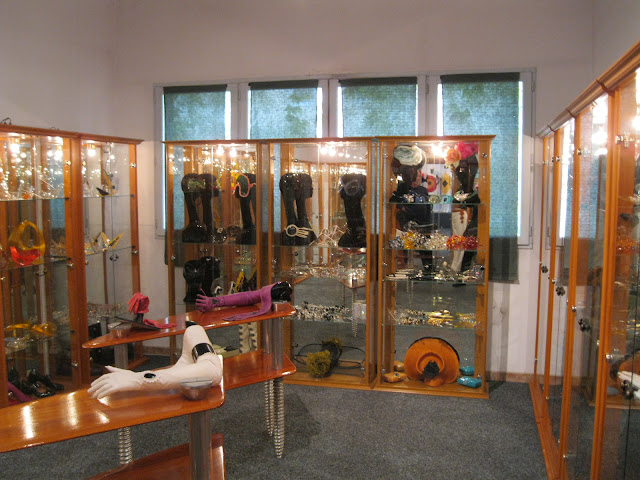It stopped raining long enough on Sunday to make a run for the Metro and take a long train ride to Saint-Ouen, beyond the Périphérique (the ring road that surrounds the 20 Paris arrondissements).
Not far from the Saint-Ouen station, we found the Musée Pierre Cardin. An unlikely suburb for a museum but this is purely private and something of a labour of love.
Only open Thursday, Friday, Saturday and Sunday from 2pm until 7pm, the museum offers about 700 exhibits at any time, but has thousands of pieces in the archives.
Such a bland entry.
Meet my new best friend. This is Renée Taponier, Curator of the Musée de la Mode and Assistant to M. Pierre Cardin himself. Or so says her business card.
Because we were from Australie, so far away, and because she loved Paul's French and because she wasn't all that busy, she took us on a private tour of the whole display.
But that is not the best part - she let me TOUCH everything. All the beautiful fabrics, the boning, the stiffening, the fastenings. She showed me how the designs were constructed and fabricated, what held them up, how they made the fabric curve, and puff, and pleat, and lay perfectly flat.
The view from the front door. There is a mezzanine, a basement and two side rooms leading off this 'grande salon'.
We began in the 1950's. Every garment on display was made for a runway model and was shown in a haute-couture parade.
Into the sixties.
Still the sixties.
Hand beaded with crystal sequins. 1970's.
My favourite, black silk velvet and silk lace. From the 1980's. Entirely wearable but incredibly flimsy.
More silk velvet and lace.
Fabulous!
The bride and the mother-of-the-bride. 1980's.
Cardin had a finger in every design pie around - he is most often criticised for spreading himself too broadly and thus diluting his focus on women's haute-couture. He was the first coutourier to open a boutique in the late fifties, the first to go into men's ready to wear, restaurant design and department store sales.
This museum displays many exquisite examples of the furniture range he designed and sold in the 70's and 80's. Most are finished in what Renée called black lacquer but seemed to be more like two-pak. The ladies writing desk below is in black, fitted with teak.
Into a side room for gloves, shoes, jewellery and hats.






Renée began an apprenticeship with the House of Cardin as a seamstress when she was 14. She has worked for him ever since, with brief stints as a model in her twenties. Apparently her work at the Musée is pretty much a labour of love.
Such a charming woman and such a treat for me ... to be able to touch everything! And Paul was incredibly patient as he translated sewing terminology from one language to the other and back again.
And we both now know more about crinoline (the stiffening used to create all those fabulous sculpted curves) than any person ever needs to know.













I want to try on those hats. All of them
ReplyDeletecheers
Doreen xo
Wow that would have been exciting. I look forward to flicking through the book when you return. Cheers Vicki
ReplyDelete